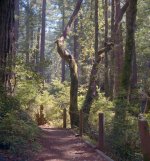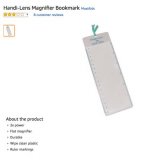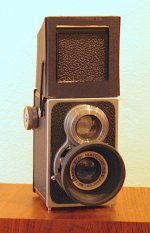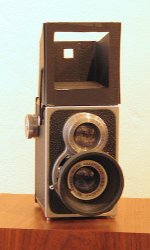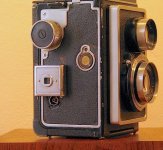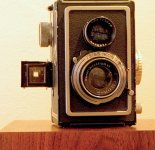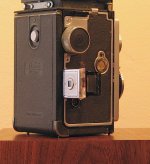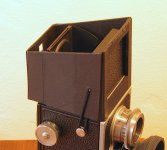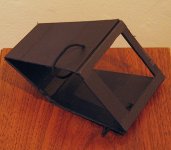Kevin Brown
Established
Hi all - first time posting.
Just wanted to share some tweaks I did to a couple of older TLRs that others might find useful.
-Gear-focus Ricoflexes (mine's a VI). The lens on this guy really impressed me, but the film door leaked light like crazy. I don't know if mine had had it's black yarn replaced at some point with something undersized or what, but the leaks were very bad. I replaced the yarn with black suede lace from the craft store (1/8" RealeatheR Craft Lace); made the back a bit tight to close but works great. While I was doing this I spotted a serious design flaw in these cameras - there is quite a gap between either side of the film insert and the thin sheet metal camera body. When picking up the camera by grabbing it by it's sides, the body flexes inwards a lot, compromising the yarn light seal. By simply adding approx. 1/8th in. thick spacers to both sides of the film insert, the body is prevented from flexing inward when grasping the camera. This little guy is now completely light-tight! Following an on-line tip, I added a flat fresnel office-supply magnifier on top of the ground glass (between the ground glass and the eye); now the corners are nice and bright. Since these early models had no sport-finder, I cut one out of black mat board that simply slips over the open hood; when not needed I don't even know it's there; to use I just fold down the hood and there it is. The only thing really preventing this from now being a great user camera is the ridiculous lack of shutter speeds!
- The Ikoflex I (post-war model). Absolutely great camera, but I found that in the kind of strong backlighting situations I shoot under a lot, the lack of internal baffling (like the Rollei and Autocords have) really produces noticeable localized contrast reduction in the images. I cooked up a very effective anti-reflective coating that doesn't require any exotic materials. It's 2 parts Liquitex Mars Black Soft-Body Acrylic artist's paint, 1 part the same in Dioxzine Purple and as much marble dust (available at better art-supply stores) as the paint will hold and still be reasonably 'brushable'. This needs to be applied to the camera interior with very little paint on the brush, in a tapping up and down motion with brush held vertically. The marble dust creates a matte finish. Having too much paint on the brush will cause it to dry with too much shine; the vertical, tapping application gives the coating a bit of texture making it even less reflective. I've found that the most important property of camera interiors is not 'blackness' as much as it is 'matte-ness'.
The other little hot-rod I did to this camera (since it's also too early a model to have a sport-finder), is to add a folding optical finder from an unused Ikonta B (don't worry it's unharmed) to the right side of the camera body, in line with the optical axis of the taking lens - folds flat out of the way when not needed. Actually has considerably less parallax than the usual frame-finder in the viewing hood. I was 'lucky' that this Ikoflex was missing the leather panel from that side of the camera, so I just stuck the finder on with 'exterior-grade' double-stick tape, since I didn't have to be concerned with harming the leather if I ever want to remove the finder.
I'll follow up with some photos as soon as I get a chance.
This from the modded Ricohflex; on Porta 400.
Just wanted to share some tweaks I did to a couple of older TLRs that others might find useful.
-Gear-focus Ricoflexes (mine's a VI). The lens on this guy really impressed me, but the film door leaked light like crazy. I don't know if mine had had it's black yarn replaced at some point with something undersized or what, but the leaks were very bad. I replaced the yarn with black suede lace from the craft store (1/8" RealeatheR Craft Lace); made the back a bit tight to close but works great. While I was doing this I spotted a serious design flaw in these cameras - there is quite a gap between either side of the film insert and the thin sheet metal camera body. When picking up the camera by grabbing it by it's sides, the body flexes inwards a lot, compromising the yarn light seal. By simply adding approx. 1/8th in. thick spacers to both sides of the film insert, the body is prevented from flexing inward when grasping the camera. This little guy is now completely light-tight! Following an on-line tip, I added a flat fresnel office-supply magnifier on top of the ground glass (between the ground glass and the eye); now the corners are nice and bright. Since these early models had no sport-finder, I cut one out of black mat board that simply slips over the open hood; when not needed I don't even know it's there; to use I just fold down the hood and there it is. The only thing really preventing this from now being a great user camera is the ridiculous lack of shutter speeds!
- The Ikoflex I (post-war model). Absolutely great camera, but I found that in the kind of strong backlighting situations I shoot under a lot, the lack of internal baffling (like the Rollei and Autocords have) really produces noticeable localized contrast reduction in the images. I cooked up a very effective anti-reflective coating that doesn't require any exotic materials. It's 2 parts Liquitex Mars Black Soft-Body Acrylic artist's paint, 1 part the same in Dioxzine Purple and as much marble dust (available at better art-supply stores) as the paint will hold and still be reasonably 'brushable'. This needs to be applied to the camera interior with very little paint on the brush, in a tapping up and down motion with brush held vertically. The marble dust creates a matte finish. Having too much paint on the brush will cause it to dry with too much shine; the vertical, tapping application gives the coating a bit of texture making it even less reflective. I've found that the most important property of camera interiors is not 'blackness' as much as it is 'matte-ness'.
The other little hot-rod I did to this camera (since it's also too early a model to have a sport-finder), is to add a folding optical finder from an unused Ikonta B (don't worry it's unharmed) to the right side of the camera body, in line with the optical axis of the taking lens - folds flat out of the way when not needed. Actually has considerably less parallax than the usual frame-finder in the viewing hood. I was 'lucky' that this Ikoflex was missing the leather panel from that side of the camera, so I just stuck the finder on with 'exterior-grade' double-stick tape, since I didn't have to be concerned with harming the leather if I ever want to remove the finder.
I'll follow up with some photos as soon as I get a chance.
This from the modded Ricohflex; on Porta 400.
Attachments
Last edited:


